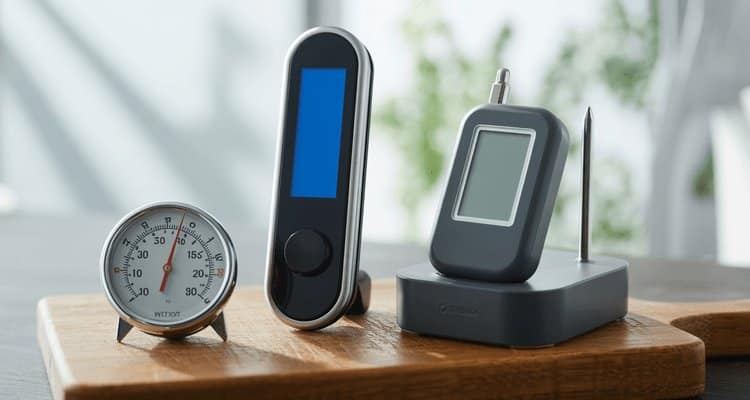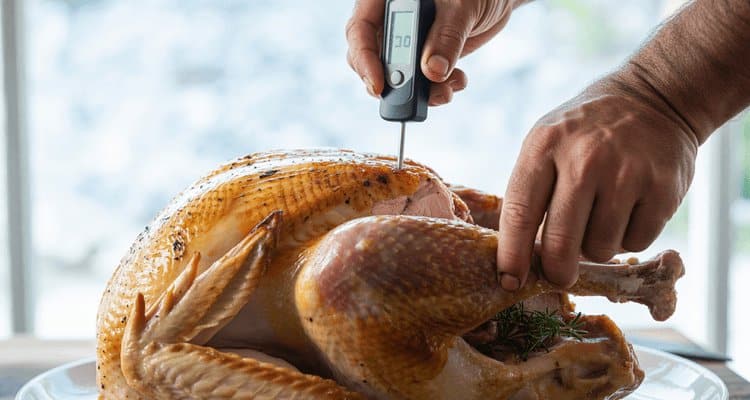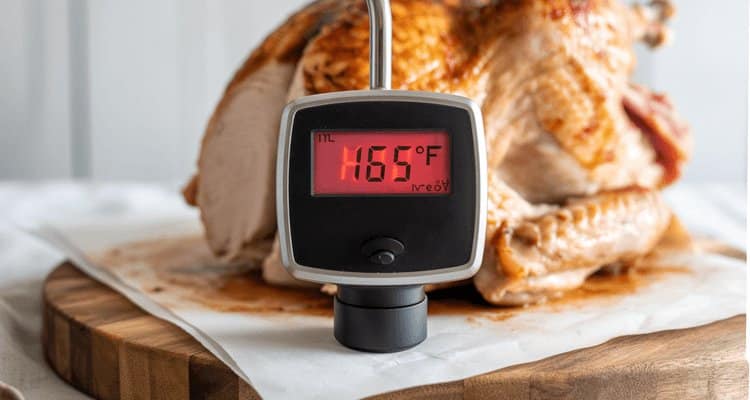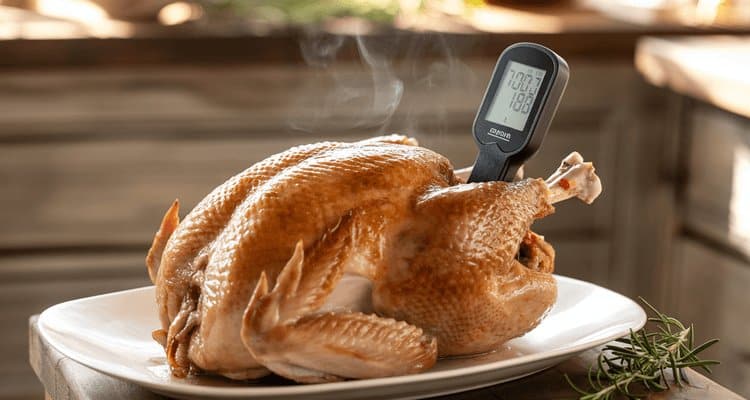
The difference between dry, sawdust-textured turkey and juicy, tender perfection comes down to one critical factor: temperature accuracy. While millions of home cooks rely on those little plastic pop-up timers that come pre-inserted in store-bought turkeys, these convenient indicators are actually sabotaging your Thanksgiving dinner.
Pop-up timers are calibrated to trigger at 180-185°F—a temperature so high that your turkey breast has already crossed into the overcooked danger zone by the time that red stem pops up.
The solution is simple: invest in a reliable meat thermometer for turkey and learn the proper placement technique. We’ll show you exactly where to insert your thermometer for accurate readings and help you choose which thermometer works best for your cooking style.
Whether you’re looking for a budget-friendly instant-read thermometer or a high-tech wireless probe that monitors your bird from your smartphone, we’ve tested the top options available today.
Quick Roundup List
- Best Budget Digital: ThermoPro TP03B
- Best Leave-In: ThermoPro TP16
- Best Wireless: MEATER Plus
- Best Premium: Lavatools Javelin PRO Duo
- Best Value Leave-In: Taylor Digital Leave-In Thermometer
Why Pop-Up Timers Don’t Work
If you’ve ever carved into a Thanksgiving turkey only to find dry, stringy breast meat, you can probably thank that innocent-looking pop-up timer.
Here’s the problem: these spring-loaded plastic indicators are manufactured to trigger at temperatures between 180°F and 185°F. While this temperature range might have made sense decades ago when food safety guidelines were more conservative, modern USDA standards confirm that poultry is perfectly safe to eat at 165°F.
That 15-20 degree difference is enormous when it comes to meat texture and moisture retention. By the time your pop-up timer pops at 180°F, the proteins in the breast meat have contracted so tightly that they’ve squeezed out most of their natural juices.
Consumer Reports has consistently advised against relying on pop-up timers. Even Butterball—the company that pioneered these timers in the 1960s—now recommends verifying doneness with an actual meat thermometer.
The better alternative is a quality meat thermometer that gives you complete control over the exact temperature. With an accurate thermometer, you can pull your turkey from the oven at precisely 165°F, ensuring every bite is juicy, tender, and perfectly cooked.
Types of Meat Thermometers for Turkey

Before diving into specific product recommendations, it’s helpful to understand the main categories of meat thermometers and how each type excels in different cooking scenarios.
Digital Instant-Read Thermometers
These are the Swiss Army knives of the thermometer world—portable, fast, and incredibly versatile. Digital instant-read thermometers typically deliver temperature readings in 3-5 seconds, making them ideal for quick spot checks during the cooking process.
Most models feature foldable probe designs, backlit displays for low-light conditions, and magnetic backs so you can stick them to your oven when not in use.
The main advantage is speed and convenience. You can quickly check multiple spots on your turkey—both breasts, both thighs, and even the stuffing. They’re also budget-friendly, with excellent models available for under $15.
The tradeoff is that you need to open your oven door each time you want a reading, which releases heat and can extend cooking time slightly.
Best for: Cooks who want an affordable, multipurpose thermometer for quick temperature checks.
Probe-Style Leave-In Thermometers
These thermometers consist of a metal probe connected to a display unit via a long heat-resistant wire. You insert the probe into your turkey before it goes into the oven, route the wire out through the oven door, and the external display shows real-time temperature updates throughout the entire cook.
Many models include USDA preset temperatures for different proteins and programmable alarms that beep when your turkey reaches the target temperature.
The biggest advantage is continuous monitoring without opening the oven door. This maintains consistent heat and eliminates guesswork—you’ll know exactly when your turkey is done.
Best for: Set-it-and-forget-it cooks who want hands-off monitoring and precise alerts.
Wireless Smart Thermometers
These represent the cutting edge of temperature monitoring technology. Wireless smart thermometers are completely wire-free—the probe stays inside your turkey while transmitting temperature data via Bluetooth to a smartphone app.
The app provides real-time temperature graphs, estimated finish times, and push notifications when your turkey reaches the target temperature. Some models can even estimate carryover cooking and tell you the optimal time to remove your turkey from heat.
The convenience factor is unmatched: you can monitor your turkey from anywhere in your home or yard. The downside is price—these thermometers typically cost $70-100.
Best for: Tech-savvy cooks who want precision, convenience, and the ability to monitor from anywhere.
Product Reviews
ThermoPro TP03B Digital Instant-Read Thermometer – Best Budget Digital
The ThermoPro TP03B delivers professional-grade accuracy at an entry-level price point. This ultra-fast instant-read thermometer provides temperature readings in just 3-4 seconds, making it perfect for quick spot-checks during the hectic Thanksgiving rush.
The foldable 4.5-inch probe is long enough to reach the deepest parts of even the largest turkeys, while the backlit display ensures you can read temperatures clearly in dim kitchen lighting.
At under $15, this thermometer delivers accuracy within ±0.9°F and covers a wide temperature range from -58°F to 572°F. The IPX6 waterproof rating means you can rinse it under the faucet for easy cleaning.
Highlights
- Ultra-fast 3-4 second readings eliminate guesswork
- Backlit display provides clear visibility in low-light conditions
- 4.5-inch probe reaches deep into large turkeys
- IPX6 waterproof rating allows easy cleaning
- Magnetic back and hanging hole offer convenient storage
- Auto-off feature extends battery life significantly
Specifications
- Temperature Range: -58°F to 572°F (-50°C to 300°C)
- Accuracy: ±0.9°F (±0.5°C)
- Response Time: 3-4 seconds
- Probe Length: 4.5 inches
- Water Resistance: IPX6 waterproof
- Power: 1 x LR44 battery (included)
Customer Reviews
- “This thermometer has been a game-changer for my holiday cooking. The reading is fast and accurate.”
- “For the price, you can’t beat it. I’ve used it for everything from turkey to steaks.”
- “The magnet on the back is super convenient. I keep it stuck to my oven.”
ThermoPro TP16 Large LCD Digital Cooking Thermometer – Best Leave-In
The ThermoPro TP16 combines the convenience of continuous monitoring with the reliability of USDA-calibrated presets. This leave-in thermometer features a long stainless steel probe connected to an external display unit.
The standout feature is the programmable temperature alert system. Simply set your target temperature, insert the probe, and the unit will beep loudly when your turkey reaches the desired doneness.
With USDA-recommended temperature presets for eight different meat types and five doneness levels, this thermometer takes the guesswork out of cooking. The 40-inch heat-resistant cable is long enough to route from your oven to the countertop.
Highlights
- USDA preset temperatures for 8 meat types and 5 doneness levels
- Programmable high and low temperature alarms with loud alerts
- Large backlit LCD displays current and target temperatures
- 40-inch stainless steel cable with heat resistance up to 716°F
- Magnetic backing and kickstand for versatile placement
- Built-in timer function for tracking multiple cooking stages
Specifications
- Temperature Range: 32°F to 572°F (0°C to 300°C)
- Accuracy: ±1.8°F (±1°C)
- Probe Cable Length: 40 inches (102 cm)
- Cable Heat Resistance: Up to 716°F (380°C)
- Power: 2 x AAA batteries (included)
- Special Features: Timer, alarm, USDA presets
Customer Reviews
- “This thermometer is a lifesaver on Thanksgiving. I can monitor the turkey while prepping side dishes.”
- “The alarm is loud enough to hear from another room. Perfect for busy kitchens.”
- “Love the preset temperatures. Takes all the guesswork out of cooking.”
MEATER Plus: Long Range Smart Wireless Meat Thermometer – Best Wireless
The MEATER Plus represents the future of meat temperature monitoring. This completely wireless probe eliminates all cables—both between the probe and display, and between the display and your smartphone.
The sleek stainless steel probe contains dual temperature sensors: one at the tip to measure internal meat temperature (up to 212°F) and one near the handle to monitor ambient cooking temperature (up to 527°F).
The accompanying smartphone app transforms temperature monitoring into an interactive experience. Real-time temperature graphs show exactly how your turkey is progressing, while the guided cook system walks you through the entire process with step-by-step instructions.
With 165-foot Bluetooth range (via the included charging case), you can monitor your turkey from virtually anywhere in your home or yard.
Highlights
- 100% wire-free design eliminates all cables
- Dual temperature sensors track both meat (up to 212°F) and ambient temp (up to 527°F)
- Guided cook system provides step-by-step instructions via app
- Advanced algorithm estimates finish times and accounts for carryover cooking
- 165-foot Bluetooth range allows monitoring from anywhere
- Rechargeable probe with magnetic charging case
- Unlimited cloud storage saves cook history
Specifications
- Internal Meat Temp Range: Up to 212°F (100°C)
- Ambient Temp Range: Up to 527°F (275°C)
- Bluetooth Range: 165 feet (50 meters) with repeater case
- Probe Length: 5.1 inches (129 mm)
- Accuracy: ±1.8°F (±1°C)
- Battery Life: Up to 24 hours per charge
- Compatibility: iOS 12.2+ and Android 7.0+
Customer Reviews
- “The MEATER Plus is worth every penny. Being able to check the turkey from my phone is incredible.”
- “The app is intuitive and provides so much useful information. The estimated time feature is surprisingly accurate.”
- “No wires means I can close my oven door properly and maintain consistent heat.”
Lavatools Javelin PRO Duo Ambidextrous Backlit Professional Digital Instant Read Meat Thermometer – Best Premium
The Lavatools Javelin PRO Duo represents the pinnacle of instant-read thermometer technology. This professional-grade instrument delivers temperature readings in just 2-3 seconds—faster than any other thermometer in its class.
The anti-bacterial BioCote coating on the probe reduces bacteria growth by 99.99%, making it ideal for busy kitchens where cross-contamination risks run high.
The ambidextrous rotating display automatically orients itself for easy reading regardless of which hand you’re using or the angle at which you’re holding the thermometer. The military-grade IP65 splash-proof design means you can use it in any kitchen environment.
Highlights
- Ultra-fast 2-3 second response time for instant readings
- Anti-bacterial BioCote coating reduces bacteria by 99.99%
- Ambidextrous rotating display automatically orients for easy reading
- IP65 splash-proof rating withstands harsh kitchen environments
- 4,000+ hour battery life with aggressive auto-sleep mode
- Stabilizing beveled edge prevents rolling when set down
- Large backlit display readable in all lighting conditions
Specifications
- Temperature Range: -40°F to 482°F (-40°C to 250°C)
- Accuracy: ±0.9°F (±0.5°C) from 32°F to 482°F
- Response Time: 2-3 seconds
- Probe Length: 4.5 inches (114 mm)
- Water Resistance: IP65 splash-proof
- Power: 1 x CR2032 battery (included)
Customer Reviews
- “Professional quality at a reasonable price. The 3-second readout is perfect when juggling multiple dishes.”
- “The rotating display is genius. Makes it so much easier to read temps at awkward angles.”
- “Built like a tank. I’ve dropped it multiple times and it still works perfectly.”
Taylor Digital Leave-In Meat Thermometer with Programmable Temperature Settings – Best Value Leave-In
The Taylor Digital Leave-In Thermometer delivers professional-level features at a fraction of the cost of premium wireless models.
This reliable workhorse has been a staple in both home and commercial kitchens for years, earning its reputation through consistent performance and straightforward functionality.
The programmable temperature alert system lets you set both high and low alarms, ensuring you’ll never miss the perfect doneness moment. The built-in timer function is particularly useful for turkey cooking.
Highlights
- Programmable high and low temperature alarms prevent overcooking
- Built-in timer function tracks cooking duration simultaneously
- 4-foot heat-resistant cable allows flexible positioning
- Simple three-button interface is intuitive to program
- Kickstand and hanging hook provide multiple mounting options
- Excellent value for reliable leave-in monitoring
Specifications
- Temperature Range: 32°F to 392°F (0°C to 200°C)
- Accuracy: ±2°F (±1°C)
- Probe Cable Length: 4 feet (122 cm)
- Power: 1 x AAA battery (included)
- Special Features: Dual alarms, timer, memory function
Customer Reviews
- “Simple, reliable, and affordable. I’ve been using mine for 5+ years without issues.”
- “The timer feature is so useful. I can track both time and temperature without juggling devices.”
- “Great value thermometer. Does everything I need without unnecessary complexity.”
Where to Insert a Meat Thermometer in Turkey

Proper thermometer placement is just as important as choosing the right thermometer. Insert it in the wrong spot, and you’ll get inaccurate readings that lead to undercooked or overcooked meat.
Check the Turkey Breast
The breast is the first place to check because white meat cooks faster than dark meat and is more prone to drying out.
Insert your thermometer into the thickest part of the breast, aiming for the center of the muscle mass. Insert the probe from the side of the breast, not from the top, angling it horizontally parallel to the cutting board.
Make sure the probe doesn’t touch bone—if you feel hard resistance, back out and adjust your angle. For instant-read thermometers, ensure the entire sensor area (typically the first 1-2 inches of the probe tip) is fully inserted into the meat.
The target temperature for turkey breast is 165°F for food safety. However, many professional chefs pull the breast at 160°F and allow carryover cooking during the resting period to bring it up to 165°F.
Check the Thickest Part of the Thigh
Dark meat benefits from slightly higher temperatures than white meat. The connective tissue in thighs breaks down more completely at higher temps, resulting in more tender, flavorful meat.
Insert the probe from the top of the thigh, aiming downward at an angle. Push the probe into the thickest part of the thigh muscle (usually the inner thigh area). Avoid the bone—thigh bones are large and easy to hit, but touching bone will give false readings.
The ideal temperature for turkey thighs is 170-175°F. At this temperature range, the collagen in the connective tissue has fully broken down, creating rich, tender meat.
Check Both Sides
Don’t assume both sides of your turkey are cooking at the same rate. Oven hot spots, uneven heat distribution, and positioning can cause one side to cook faster than the other.
Always check both breasts and both thighs—your turkey isn’t done until the coolest spot reaches the target temperature.
Understanding Turkey Temperature Zones

Not all parts of your turkey cook at the same rate, and different cuts actually benefit from different target temperatures.
White Meat (Breast): 160-165°F
Turkey breast is lean, with minimal fat content and no connective tissue to break down. This means it cooks relatively quickly and becomes dry if overcooked.
The USDA safe minimum temperature is 165°F, but most professional chefs pull the breast at 160°F and rely on carryover cooking during the resting period to bring it up to 165°F.
This technique results in noticeably juicier meat. During the 20-30 minute resting period, the internal temperature will continue to rise 5-7 degrees.
Dark Meat (Thighs and Legs): 170-175°F
Thighs and drumsticks contain significantly more fat and connective tissue than breast meat. This connective tissue (collagen) needs to reach higher temperatures to break down properly.
While dark meat is technically safe to eat at 165°F, it will be tough and chewy at that temperature because the collagen hasn’t fully converted to gelatin.
For the most tender, flavorful dark meat, target 170-175°F. At these temperatures, the collagen breaks down completely, the meat becomes fall-off-the-bone tender, and the extra fat keeps everything moist and rich.
The Science of Carryover Cooking

Carryover cooking is one of the most important concepts in meat preparation, yet it’s often overlooked by home cooks.
Understanding and leveraging carryover cooking is the difference between good turkey and exceptional turkey.
What Is Carryover Cooking?
Carryover cooking refers to the phenomenon where meat continues to cook even after it’s been removed from the heat source. When you pull your turkey from the oven, the outer layers are significantly hotter than the interior.
During the resting period, this heat continues to penetrate inward, raising the internal temperature by 5-10°F depending on the size of the bird.
How to Leverage Carryover Cooking
Professional chefs use carryover cooking to their advantage by pulling meat at slightly lower temperatures than the target. Here’s how to apply this technique to turkey:
- Remove turkey when breast reaches 160°F (not 165°F)
- Tent loosely with foil to retain some heat without trapping too much steam
- Rest for 20-30 minutes on a carving board or serving platter
- Verify final temperature before carving: Breast should read 165-167°F after resting
This technique ensures your breast meat reaches the safe 165°F minimum without overcooking.
The result is noticeably juicier, more tender white meat that doesn’t require drowning in gravy.
Pro Tips for Accurate Readings
These advanced techniques help you get professional-level results with any thermometer.
Always Avoid Bones
Bones conduct heat faster than meat, so if your probe touches bone, you’ll get a reading that’s 5-10°F higher than the actual meat temperature. This is the single most common cause of undercooked turkey.
When inserting your probe, aim for the center of muscle tissue and angle away from the skeleton. If you feel hard resistance, you’ve hit bone—back out and adjust your angle.
Check Multiple Spots
Your turkey doesn’t cook evenly. One breast may be 5 degrees hotter than the other due to oven hot spots. The thighs cook more slowly than the breast.
Always check at least four locations: both breasts and both thighs. Your turkey isn’t done until the coolest spot reaches your target temperature.
Calibrate Regularly
Even expensive thermometers can lose accuracy over time. Calibrate your thermometer at the beginning of each cooking season using the ice water test or boiling water test.
This 2-minute check ensures your readings are accurate and prevents both undercooking and overcooking.
Ice Water Test:
- Fill a glass with ice and add cold water
- Stir and let sit for 1 minute
- Insert thermometer probe into the ice water (not touching sides or bottom)
- Reading should be 32°F (±2°F)
- If off by more than 2°F, recalibrate according to manufacturer instructions
Account for Carryover Cooking
Pull your turkey when the breast reaches 160°F, not 165°F. During the 20-30 minute resting period, carryover cooking will bring the internal temperature up to 165-167°F.
This prevents overcooking and results in significantly juicier meat. This is how professional chefs achieve restaurant-quality results at home.
Conclusion: Master Temperature, Master Turkey
Cooking the perfect turkey isn’t about luck, expensive ingredients, or complicated techniques. It’s about understanding and controlling one simple variable: internal temperature.
By investing in a reliable meat thermometer and learning proper placement technique, you eliminate guesswork and gain complete control over your results.
Remember these key takeaways:
- Pop-up timers are calibrated to 180-185°F, which results in overcooked, dry meat
- The USDA safe minimum temperature is 165°F for all parts of the turkey
- Pull breast meat at 160°F and let carryover cooking bring it to 165°F during resting
- Dark meat (thighs/legs) benefits from higher temperatures: 170-175°F for maximum tenderness
- Proper probe placement is critical: insert into the thickest part, avoid bones
- Check multiple spots (both breasts, both thighs) to ensure even cooking
- Always rest your turkey for at least 20-30 minutes before carving
When it comes to choosing a thermometer, consider your cooking style and budget. Budget-conscious cooks will get excellent results from the ThermoPro TP03B instant-read thermometer. Hands-off cooks who want continuous monitoring should choose the ThermoPro TP16 leave-in model.
Tech enthusiasts who want smartphone connectivity and precision will love the MEATER Plus wireless thermometer. And serious cooks who demand professional-grade speed should invest in the Lavatools Javelin PRO Duo.
Whatever thermometer you choose, the most important step is actually using it. Don’t trust timers, don’t trust cooking charts, and definitely don’t trust pop-up indicators. Trust the temperature.
Insert your probe, verify doneness at multiple spots, and pull your turkey at exactly the right moment. The difference between “acceptable” turkey and “amazing” turkey is often just 5-10 degrees—and a quality thermometer ensures you nail that target every single time.
Contents








